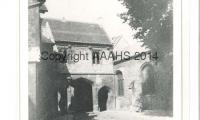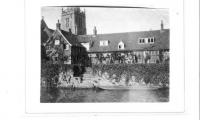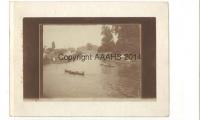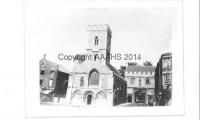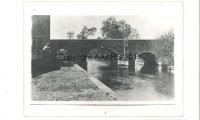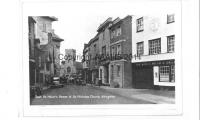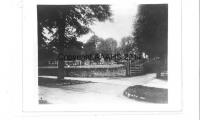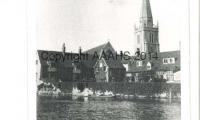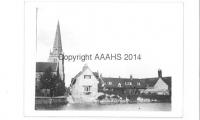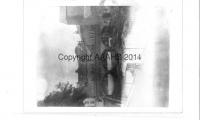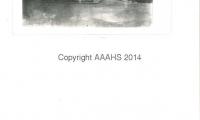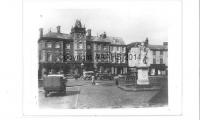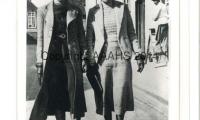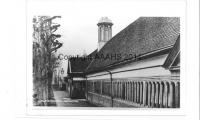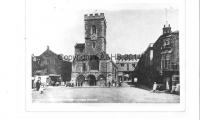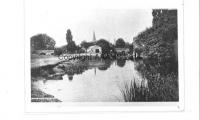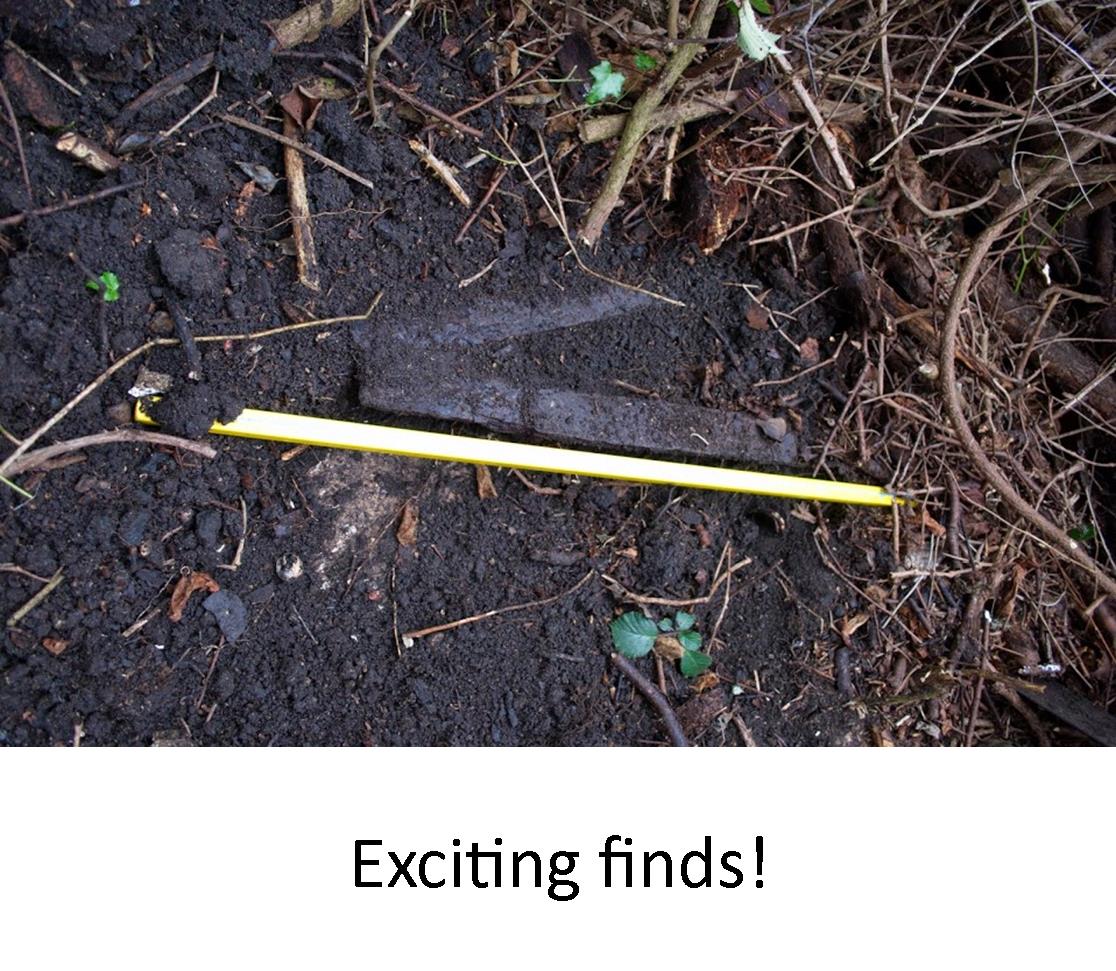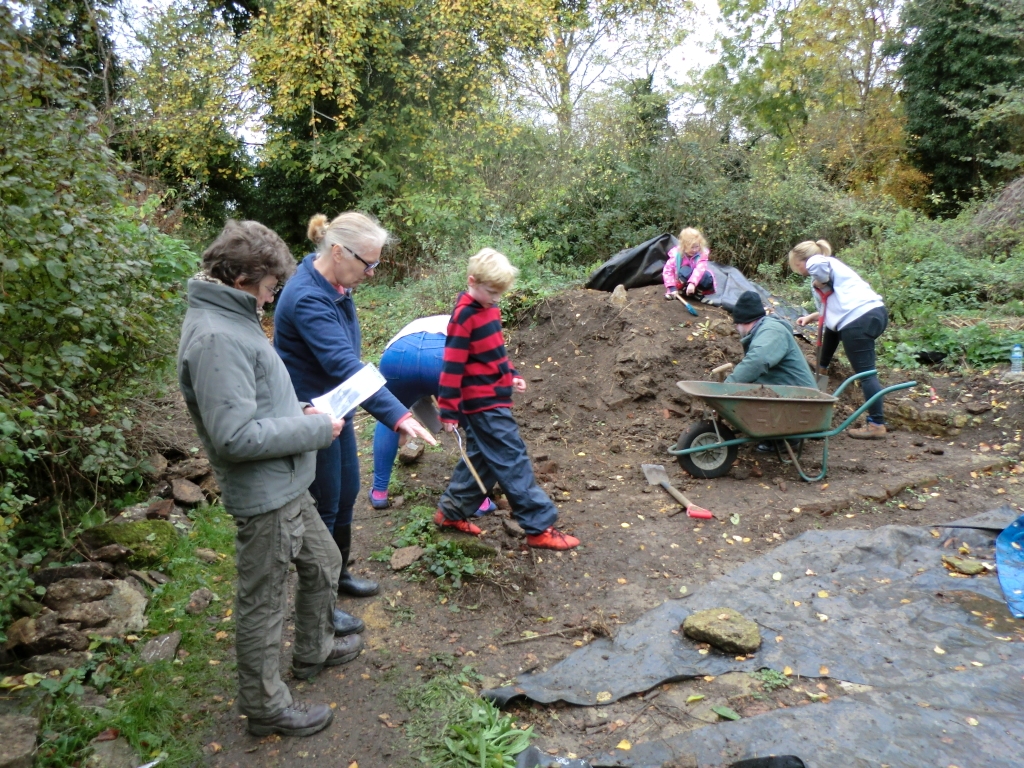The Shrieve’s Cottage Dig in Sunningwell
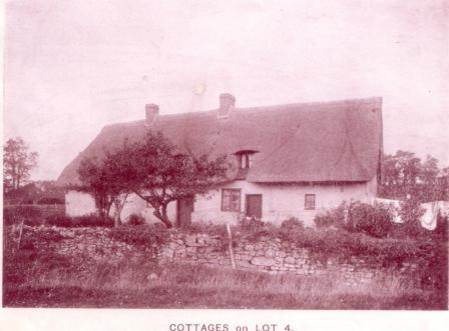 Near the Sunningwell Primary School are the remains of an old building, remembered in the village by the name of Shrieve’s (or Cobbler’s) Cottage, which was still standing in the 1930s. [The image on the left shows the Cottage in 1912] The Trustees of the School, with the support of the AAAHS, are excavating the site.
Near the Sunningwell Primary School are the remains of an old building, remembered in the village by the name of Shrieve’s (or Cobbler’s) Cottage, which was still standing in the 1930s. [The image on the left shows the Cottage in 1912] The Trustees of the School, with the support of the AAAHS, are excavating the site.

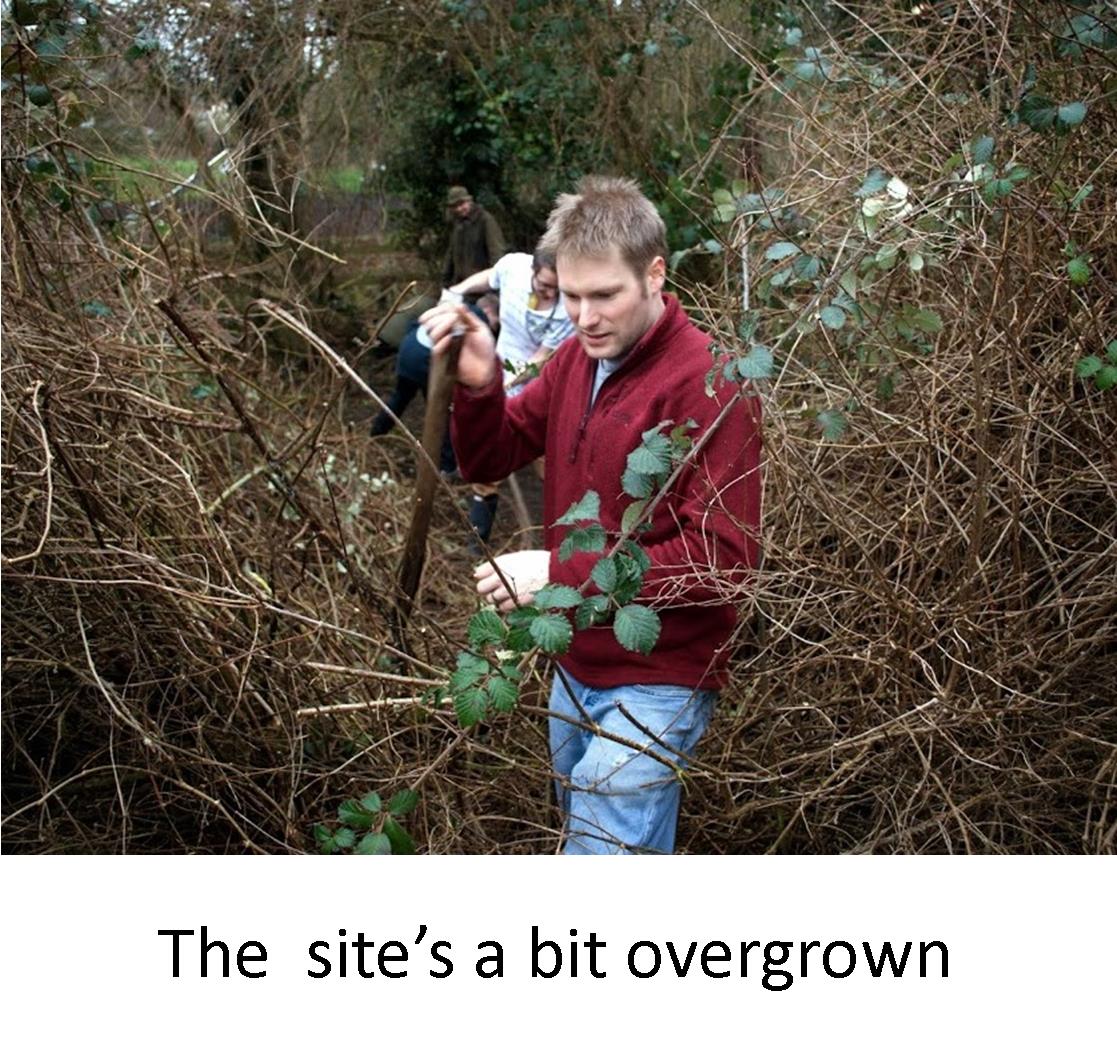 At the time of writing (March 2015) there have been two digging sessions. We have exposed paths around the house, particularly a handsome cobbled one on the south side that seems to have led to the front door. At the back, in a northerly direction, and to the east, are signs of some similar features. The most prominent surviving piece of the cottage itself is part of a fireplace, and we have uncovered low stone and brick walls (perhaps the lower part of the chimney stack?) in proximity to it, as well as what might be large flat terracotta tiled steps leading to a higher level in the house.
At the time of writing (March 2015) there have been two digging sessions. We have exposed paths around the house, particularly a handsome cobbled one on the south side that seems to have led to the front door. At the back, in a northerly direction, and to the east, are signs of some similar features. The most prominent surviving piece of the cottage itself is part of a fireplace, and we have uncovered low stone and brick walls (perhaps the lower part of the chimney stack?) in proximity to it, as well as what might be large flat terracotta tiled steps leading to a higher level in the house.
We have so far found pieces of china, some of them glazed, and cutlery, including the bone handle of a knife. We have picked up various metal items, among them rusted frames, bits of guttering and a large file. Our collection also includes the remains of a clay pipe and other bric-a-brac. Prize discovery so far is a white enamel (?chamber) pot, so fragile that we haven’t yet dared excavate it fully. And everywhere there are bricks and tiles, mostly no doubt from roofs and walls on and around the building. Since the size, shape and quality of such artefacts changed over time, they should offer clues for dating different phases of construction.
If you would like more information about the project, please contact either Bob Evans or Anita Leech or the AAAHS here.
Shrieve Cottages Update, August 2015
Since the last upload we have had half-a-dozen digging sessions and made some real progress. Above all, it’s been fun: we are a rough and ready team of school staff, governors, and supporters, with help from several members of the AAAHS, above all Roger Thomas as our chief professional adviser, and some visiting experts (see below). There’s no hurry – this isn’t rescue archaeology – and no external taskmaster; so we can make our discoveries at leisure.
And exciting discoveries there have been already. We started by clearing the surrounds of the site, to establish 
an exact footprint for the building. That quickly yielded a fine section of access path, sturdily but attractively constructed, and a cobbled area at the back, along with other evidence of the line of external walls. Inside the task proved harder, even though the surviving base of one of the chimneys has been a conspicuous feature from the start. It soon became evident that much of the fabric had been simply collapsed inwards when the place was demolished circa 1940, so we’ve found mounds of stone, mainly undressed, and bricks and tiles, of various shapes and sizes, most of it presumably from local quarries on Boars Hill and some no doubt roughly dateable if we can call on the right expertise.
 The real breakthrough so far came when we finally located part of a stone floor, coarse and uneven, but definitely homely. So we now know the dimensions of one of the rooms. With more specialized techniques we’ve had mixed fortunes as yet. The film-maker John Tolson, besides recording some of our proceedings, sent up a drone, which supplied excellent aerial shots of the whole site. But we’re still searching for a well, despite the best efforts of a water-diviner (who did, however, tell us where he believes the cottage doors and windows must have been). With the help of botanist friends we tried to find evidence of former gardening and husbandry, but only a few fruit trees appear to have survived the long period of neglect.
The real breakthrough so far came when we finally located part of a stone floor, coarse and uneven, but definitely homely. So we now know the dimensions of one of the rooms. With more specialized techniques we’ve had mixed fortunes as yet. The film-maker John Tolson, besides recording some of our proceedings, sent up a drone, which supplied excellent aerial shots of the whole site. But we’re still searching for a well, despite the best efforts of a water-diviner (who did, however, tell us where he believes the cottage doors and windows must have been). With the help of botanist friends we tried to find evidence of former gardening and husbandry, but only a few fruit trees appear to have survived the long period of neglect.
Particularly satisfying, because so fortuitous, have been the many casual finds, including much window and bottle glass; sherds of pot and crockery; and lots of metal: nails, hinges, tools, guttering, etc. On the uncovered piece of floor lay a well-preserved lady’s shoe, reminding us that another village name for the cottages was ‘Cobblers’, as well as some bicycle parts (could they have repaired those too?). At the moment we are still at the 20th-century level, but must hope there will be similar, more ancient abandoned bric-a-brac when we penetrate deeper.
Alongside the excavation we have made a start with the documentary record. We know that a family called Shrieve was prominent in Sunningwell in the early modern period, at a time when our cottage – to judge by the photographs we have of it – would already have been in existence, and probably still in single occupancy. The AAAHS’s expert in local landholding, Richard Dudding of Radley, has found a John Shrieve in an estate survey of 1768 as renting 27 acres (plus a few roods and perches), and thus as one of a by then vanishing breed of yeoman-farmers. Now we need to confirm that our cottage was indeed the Shrieve residence. In the end we trust both written and material evidence will come together to provide a picture, for adults and for the children, of how life was lived in the village past.
Bob Evans
Shrieve Cottages Update, December 2016
It’s over a year since I last reported on our excavation. During that time we have continued with regular digging sessions, every month or two, supported by staff, AAAHS members, and other local enthusiasts. Latterly we’ve been able to welcome some children on site, with their parents. Not sure what the youngest ones make of it all; but they’ve been super-active with buckets and spades. Despite – or because of! – that, progress has been fairly slow; though that’s also in good part because we’re a sociable group: all finds are shared – and a good pretext for a coffee break, and a sausage roll.
We have at last more or less uncovered the whole floor area of the main room in the more easterly of the two cottages. When we removed both the small trees (an elder and an elm) which had barred our way, we discovered that their roots had not penetrated the solid flooring beneath them. It’s made of some kind of Victorian concrete mix. In places it bears the traces of paint. Now we’re wondering what’s underneath that.

We have made lots more finds of bits of crockery, glass, metal objects of all kinds, primitive sorts of plastic, etc. I was especially pleased to find evidence that the cottagers enjoyed the products of the old Corona works, Thomas & Evans, in the Rhondda valley. In my youth they constituted the Welsh temperance movement’s greatest gift to the English fish and chip shop: the firm’s soft drinks had originally been marketed as an alternative to alcohol. Bottles were prominent in the little exhibition we mounted in the autumn at Abingdon Library. We hope to return there with an expanded display very shortly.
Do come along, either to join in the digging or just to look around. Contact addresses as above.
Bob Evans
The Current Newsletter is: Autumn 2021
Newsletters from Summer 2002 to date
Please note that all articles are uploaded as received and are not checked for factual errors.
'The Abingdon I remember' is transcribed from a copy held by Judy White, with added sub-headings and minor changes to punctuation. The date and author are unknown. It describes Abingdon c.1920, but was probably written c.1960.
Despite being a very personal account and lack of a date or author, it is probably the best detailed description of Abingdon as it was in the early 20th century. Somebody must know who the author was?
The following document grouped under the title “Old Courts and Slums of Abingdon” was written by the late Ron Chung and is reproduced here with the support and permission of his family. The papers are notes for a book that was unfortunately not published. They contain information about the families and the various courts that they lived in and the new houses on Saxton Road.
The Chung family, though might be considered ordinary, was exceptional. Fong, known as Harry Chung came from China as part of the importation of labour during WWI. Most worked in France where many died but some worked in England. Harry worked at the Milton Depot, perhaps because he spoke English. In 1918 he married Lily Painton and settled locally though most of his compatriots were repatriated after the war. They had a number of children including Ron Chung. During WWII Ron was in 12 Commando and was part of the demolition team on the St Nazaire raid where he was captured. He was very proud of living in Abingdon and took a great interest in our town and its history.
A wealth of additional information is available in the Abingdon Buildings and People section of the Abingdon-on-Thames Town Council website. Those pages are the responsibility of the Abingdon Buildings and People group, which is part of the Abingdon Area Archaeology and History Society (AAAHS).
A wealth of additional information is available in the Abingdon Buildings and People section of the Abingdon-on-Thames Town Council website. Those pages are the responsibility of the Abingdon Buildings and People group, which is part of the Abingdon Area Archaeology and History Society (AAAHS).
A wealth of additional information is available in the Abingdon Buildings and People section of the Abingdon-on-Thames Town Council website. Those pages are the responsibility of the Abingdon Buildings and People group, which is part of the Abingdon Area Archaeology and History Society (AAAHS).
A wealth of additional information is available in the Abingdon Buildings and People section of the Abingdon-on-Thames Town Council website. Those pages are the responsibility of the Abingdon Buildings and People group, which is part of the Abingdon Area Archaeology and History Society (AAAHS).


